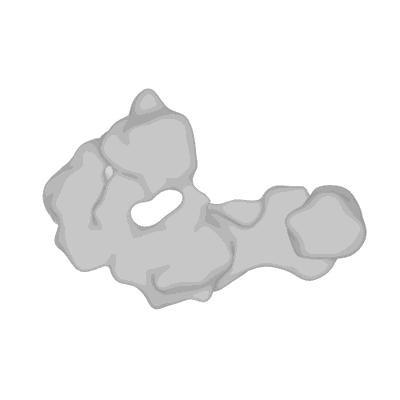EMD-17542
Negative stain map of UBR5 (dimer) in complex with RARA/RXRA
EMD-17542
Single-particle25.0 Å
 Deposition: 31/05/2023
Deposition: 31/05/2023Map released: 07/06/2023
Last modified: 27/12/2023
Sample Organism:
Homo sapiens
Sample: UBR5 in complex with RARA/RXRA
Deposition Authors: Aguirre JD ,
Cavadini S,
Kempf G,
Kater L,
Thoma NH
,
Cavadini S,
Kempf G,
Kater L,
Thoma NH 
Sample: UBR5 in complex with RARA/RXRA
Deposition Authors: Aguirre JD
 ,
Cavadini S,
Kempf G,
Kater L,
Thoma NH
,
Cavadini S,
Kempf G,
Kater L,
Thoma NH 
UBR5 forms ligand-dependent complexes on chromatin to regulate nuclear hormone receptor stability.
Tsai JM,
Aguirre JD  ,
Li YD
,
Li YD  ,
Brown J,
Focht V,
Kater L,
Kempf G,
Sandoval B,
Schmitt S,
Rutter JC,
Galli P,
Sandate CR
,
Brown J,
Focht V,
Kater L,
Kempf G,
Sandoval B,
Schmitt S,
Rutter JC,
Galli P,
Sandate CR  ,
Cutler JA,
Zou C,
Donovan KA,
Lumpkin RJ,
Cavadini S,
Park PMC,
Sievers Q,
Hatton C,
Ener E,
Regalado BD
,
Cutler JA,
Zou C,
Donovan KA,
Lumpkin RJ,
Cavadini S,
Park PMC,
Sievers Q,
Hatton C,
Ener E,
Regalado BD  ,
Sperling MT,
Slabicki M,
Kim J,
Zon R,
Zhang Z,
Miller PG,
Belizaire R,
Sperling AS,
Fischer ES,
Irizarry R,
Armstrong SA,
Thoma NH
,
Sperling MT,
Slabicki M,
Kim J,
Zon R,
Zhang Z,
Miller PG,
Belizaire R,
Sperling AS,
Fischer ES,
Irizarry R,
Armstrong SA,
Thoma NH  ,
Ebert BL
,
Ebert BL 
(2023) Mol Cell , 83 , 2753 - 2767.e10
 ,
Li YD
,
Li YD  ,
Brown J,
Focht V,
Kater L,
Kempf G,
Sandoval B,
Schmitt S,
Rutter JC,
Galli P,
Sandate CR
,
Brown J,
Focht V,
Kater L,
Kempf G,
Sandoval B,
Schmitt S,
Rutter JC,
Galli P,
Sandate CR  ,
Cutler JA,
Zou C,
Donovan KA,
Lumpkin RJ,
Cavadini S,
Park PMC,
Sievers Q,
Hatton C,
Ener E,
Regalado BD
,
Cutler JA,
Zou C,
Donovan KA,
Lumpkin RJ,
Cavadini S,
Park PMC,
Sievers Q,
Hatton C,
Ener E,
Regalado BD  ,
Sperling MT,
Slabicki M,
Kim J,
Zon R,
Zhang Z,
Miller PG,
Belizaire R,
Sperling AS,
Fischer ES,
Irizarry R,
Armstrong SA,
Thoma NH
,
Sperling MT,
Slabicki M,
Kim J,
Zon R,
Zhang Z,
Miller PG,
Belizaire R,
Sperling AS,
Fischer ES,
Irizarry R,
Armstrong SA,
Thoma NH  ,
Ebert BL
,
Ebert BL 
(2023) Mol Cell , 83 , 2753 - 2767.e10
Abstract:
Nuclear hormone receptors (NRs) are ligand-binding transcription factors that are widely targeted therapeutically. Agonist binding triggers NR activation and subsequent degradation by unknown ligand-dependent ubiquitin ligase machinery. NR degradation is critical for therapeutic efficacy in malignancies that are driven by retinoic acid and estrogen receptors. Here, we demonstrate the ubiquitin ligase UBR5 drives degradation of multiple agonist-bound NRs, including the retinoic acid receptor alpha (RARA), retinoid x receptor alpha (RXRA), glucocorticoid, estrogen, liver-X, progesterone, and vitamin D receptors. We present the high-resolution cryo-EMstructure of full-length human UBR5 and a negative stain model representing its interaction with RARA/RXRA. Agonist ligands induce sequential, mutually exclusive recruitment of nuclear coactivators (NCOAs) and UBR5 to chromatin to regulate transcriptional networks. Other pharmacological ligands such as selective estrogen receptor degraders (SERDs) degrade their receptors through differential recruitment of UBR5 or RNF111. We establish the UBR5 transcriptional regulatory hub as a common mediator and regulator of NR-induced transcription.
Nuclear hormone receptors (NRs) are ligand-binding transcription factors that are widely targeted therapeutically. Agonist binding triggers NR activation and subsequent degradation by unknown ligand-dependent ubiquitin ligase machinery. NR degradation is critical for therapeutic efficacy in malignancies that are driven by retinoic acid and estrogen receptors. Here, we demonstrate the ubiquitin ligase UBR5 drives degradation of multiple agonist-bound NRs, including the retinoic acid receptor alpha (RARA), retinoid x receptor alpha (RXRA), glucocorticoid, estrogen, liver-X, progesterone, and vitamin D receptors. We present the high-resolution cryo-EMstructure of full-length human UBR5 and a negative stain model representing its interaction with RARA/RXRA. Agonist ligands induce sequential, mutually exclusive recruitment of nuclear coactivators (NCOAs) and UBR5 to chromatin to regulate transcriptional networks. Other pharmacological ligands such as selective estrogen receptor degraders (SERDs) degrade their receptors through differential recruitment of UBR5 or RNF111. We establish the UBR5 transcriptional regulatory hub as a common mediator and regulator of NR-induced transcription.
